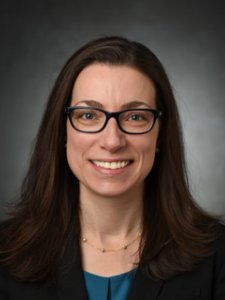
Through this IEE seed grant, this newly-collaborating interdisciplinary team aims to remove radium from hydrofracturing fluids by sorbing the radium onto tailored clays. Dr. Komarneni, through prior research published in Nature, has synthesized clays that host a tight inter-layer structure that captures radium, preferentially over other cations such as barium, sodium, etc. As a high-risk, high- gain application of this novel phenomenon, we aim to dose these tailored clays into hypersaline hydrofracturing fluids so as to sorb the fluids’ radioactivity.
Hydrofracturing fluids often contain elevated radium radioactivity ~20,000 pCi/L, levels that may raise regulatory and health concerns. They also contain high levels of salts and barium, which confound removal technologies. Other possible contaminants of concern have not been well characterized because the saline matrices require a 1,000-10,000x dilution to run using conventional methods (e.g. ICP-MS). Dr. Johnsen will introduce a novel approach using neutron activation analysis to quantify other contaminants. Drs. Warner and Johnsen will facilitate protocols for monitoring radium by (comprehensive) gamma analyses; and these will be augmented with Dr. Flaska’s rapid protocols for monitoring radioactivity by liquid scintillation. Dr. Cannon’s group has been developing protocols for separating solids from fluids by means of hydroacoustic cavitation and cyclones. Together, this treatment could mitigate radioactivity in fracturing fluids.
Via recent exploratory experiments, we have shown that with a mere 0.6 g/L tailored clay, we could remove all but about 4% of the radium when processing a 226Ra solution that was 17,500 pCi/L, about the dose commonly found in hydrofracturing fluids. In contrast, when applying common bentonite clay, this same dose left 40% of the radium in the solution. Through this grant, we will test this promising novel radium removal protocol while using a wide variety of field-collected hydrofracturing fluids. For these tests, we will apply a range of clay-tailoring protocols, clay doses, and clay sizes to the hydrofracturing fluids.
Resulting Publications
- Ajemigbitse, M.A. (Co-Supervised Student Author), Cheng, Y., Cannon, F.S., and Warner, N.R. (co-author). (Accepted) Self-attenuation corrections for radium measurements of oil and gas solids by gamma spectroscopy. Journal of Environmental Radioactivity.
- Ajemigbitse, M.A. (Co-Supervised Student Author), Tasker, T.L. (*Mentored Student Author), Cannon, F.S., and Warner, N.R. (co-author) (2019). Influence of high total dissolved solids concentration and ionic composition on γ spectroscopy radium measurements of oil and gas-produced water. Environmental Science and Technology, 53 (17) 10295-10302.
- Ajemigbitse, M.A. (Co-Supervised Student Author), Cannon, F.S., Klima, M., Furness, J.C., and Warner, N.R. (co-author) (2019). Raw material recovery from oil and gas residual waste with implications for sustainability and radioactive waste disposal. Environmental Sciences: Processes and Impacts, 21 (2), 308-323.
- Ouyang, B. (Mentored Student Author), Renock, D., Ajemigbitse, M.A. (Co-Supervised Student Author), Van Sice, K. (Supervised Student Author), Warner, N.R. (co-author), Landis, J., and Feng, X. (2019). Radium in hydraulic fracturing wastewater: Distribution in suspended solids and implications to its treatment by sulfate co-precipitation. Environmental Science: Processes and Impacts, 21 (2), 339-351.
- Tasker, T.L. (Mentored Student Author), Burgos, W.D., Ajemigbitse, M.A. (Co-Supervised Student Author), Lauer, N.E. (Mentored Student Author), Gusa, A., Kuatbek, M., May, D., Landis, J.D., Alessi, D.S., Johnsen ,A.M., Kaste, J., Headrick, K., Wilke, F.D.H., McNeal, M., Engle, M., Jubb, A., Vidic, R., Vengosh A., and Warner, N.R. (co-author) (2018). Accuracy of methods for reporting inorganic element concentrations and radioactivity in oil and gas wastewaters from the Appalachian Basin, U.S based on an inter-lab comparison. Environmental Sciences: Processes and Impacts, 21 (2), 224-241.
Resulting Presentations
- Warner, N.R., Geeza, T.J. (Supervised Student Author), and Gillikin, D. “Accumulation of oil and gas wastewater contaminants in freshwater bivalves” American Geophysical Union. Washington, DC. December 10-14, 2018.
- Warner, N.R., McDevitt, B. (Supervised Student Author), Geeza, T.J. (Supervised Student Author), Van Sice, K. (Supervised Student Author), and Gillikin, D. “Strontium, barium, and radium as tracers of oil and gas contaminant accumulation in biota and sediment” Goldschmidt Conference. Boston, MA. August, 14, 2018.
- Warner, N.R., S. Latta, M. Brittingham, M. Fantle, Geeza, T.J. (Supervised Student Author), McDevitt, B. (Supervised Student Author), Hazy, R., (Supervised Student Author), Soler, Y. “Strontium isotope ratios in riparian bird feathers as indicators of shale gas development” Ecological Society of America. New Orleans Louisiana. August 8, 2018.






